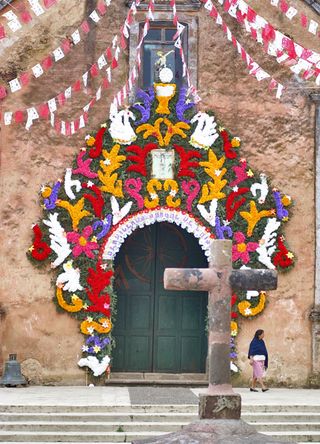
The heart of Pichátaro: Templo de San Francisco de Asís (St. Francis of Assisi Church), decorated for its annual fiestas.
Low-hanging clouds and misty rain accompanied Mexico Cooks! to San Francisco Pichátaro, Michoacán, for a day at the town's 10° Anual Feria del Mueble Rústico y Textil Bordado (10th Rustic Furniture and Embroidered Textile Fair). The event, held every August, has traditionally been an important source of pride and revenue for the town's furniture makers and hand-embroidery specialists. The drizzle stopped as we parked the car near Pichátaro's tiny centro (downtown).

Closeup of the church door, decorated for the annual fiestas as well as for the Feast of the Assumption of the Blessed Virgin Mary, celebrated annually on August 15.
Since long before the Spanish reached Michoacán in the 1521, San Francisco Pichátaro has depended on pine and oak forests for its livelihood. Today in the central highlands of Michoacán, battles for wood rights and acreage pit town against town and family against family.

Pichátaro is west and slightly north of Pátzcuaro, at the far left of the map inside the purple rectangle. Click on the map (and all photos in any Mexico Cooks! article) to improve your view.
Indigenous foresters fight constantly against illegal tree-cutting, but in recent years the area around Pichátaro has lost approximately 30 thousand thickly wooded hectáreas (approximately 75 thousand acres) per year to tree pirates. Additionally, deforestation and the planting of untold thousands of hectáreas of avocado orchards in the region have further depleted Michoacán's pine and oak forests.

Interior, Templo de San Francisco de Asís, Pichátaro.
Aside from ongoing battles to protect its wood rights, Pichátaro is also hampered by marketing problems. Pichátaro, with a population of fewer than 4,500 indigenous Purhépecha, has not historically been a tourist destination. The town is divided into seven barrios (neighborhoods), each one autonomous in making decisions about its use of natural resources. Unfortunately, some of the townspeople make their living from illegal wood cutting. Naturally there is substantial tension among some of the barrios. Given Pichátaro's multiple wood-related difficulties, we can understand why retail sales of the town's artesanía is left to vendors from other, more tourist-oriented villages.

La pila del bautizo (baptismal font), Templo de San Francisco de Asís, Pichátaro.
In spite of these difficulties, Pichátaro has reached Level Four (of five) in the development of its woodlands. Developmental levels, supervised by Mexico's National Forestry Commission, indicate how far a given community has progressed in the preservation and use of wood products for lumber, furniture, boards, doors, and other items. San Juan Parangaricutiro, Michoacán (farther west and south of Pichátaro), is one of the few communities in the state to reach Level Five.

Veladoras (votive candles), Templo de San Francisco de Asís, Pichátaro.
Pichátaro is striving for its position in Level Five. That level includes everything that Pichátaro has already accomplished in achieving Level Four, plus the creation of a stable marketing plan, principally in regions outside its current sales locations and including marketing in other countries.

Bell tower, Templo de San Francisco de Asís, Pichátaro.
More than three hundred families own and operate woodwork talleres (shops) in the town. Those woodworking shops employ nearly 1000 people and generate approximately 19 million pesos per year in income. Many of the woodworkers are eager to develop a collective mark similar to a trademark, used by all the talleres.
Poster for the 10th Annual Rustic Furniture and Embroidered Textile Fair in Pichátaro.
The collective mark belongs to a legally formed association or society
of artisans to distinguish their products from others made by
craftspeople who do not belong to the associations. That collective
trademark would be a guarantee of quality for all of Pichátaro's
clients. The woodworkers also believe that with the trademark, they'll
be able to standardize production and earn 30% more for their pieces
than they currently do.

One of many hand-carved pieces of pine furniture entered in Pichátaro's 10th annual rustic furniture competition. This gorgeous piece is a sofa, part of a three-piece sala (living room set).
The majority of furniture and other artisan work from Pichátaro is currently sold to middlemen. Craftspeople in Pichátaro barely eke out the cost of materials, while the middlemen often sell at retail prices as much as 200% higher than the wholesale price paid to the artisan. Most of the furniture produced in the town is sold unfinished; some is sold disassembled and other pieces are sold unstained.

This hand-carved pine comedor (dining room set) consists of the table base and four massive chairs.

At the 2009 all-Michoacán crafts fair in Uruapan: guanengos (traditional cross stitched blouses) from Pichátaro, entered in the textiles competition.
In addition to woodworking, Pichátaro is well known for its hand-embroidered textiles. Girls learn cross stitch embroidery from the time they are able to hold a needle. They produce aprons, napkins, tablecloths, place mats, coverlets, pillowcases, and the guanengo, the traditional Purhépecha blouse used in Michoacán. Recently Pichátaro's women have begun to create beautifully made heavy woolen jackets. A few of these are sold at the state-run Casa de Artesanía in Morelia.
Begonias on a roof terrace, Pichátaro.

Red doors, yellow wall, Pichátaro.
Well off the beaten tourist track, Pichátaro is a worthy destination. Mexico Cooks! is always happy with a new trip. We walked around town, sampled some out-of-this-world puff pastry empanadas (turnovers) filled with pastry cream, and made it back to the car just as the rain started to pelt down again.
Next time, you come with us.
Looking for a tailored-to-your-interests specialized tour in Mexico? Click here: Tours.

Leave a Reply